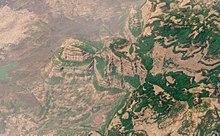
Back Dekan-trappe Afrikaans مصاطب الدكن Arabic Trapps del Dècan Catalan Dekkánské trapy Czech Dekkan-Trapp German Traps del Decán Spanish Dekkango basalto plataforma Basque Deccanin laavapurkaukset Finnish Trapps du Deccan French Trapps do Decán Galician
| Deccan Traps | |
|---|---|



The Deccan Traps are a large igneous province of west-central India (17–24°N, 73–74°E). They are one of the largest volcanic features on Earth, taking the form of a large shield volcano.[2] They consist of many layers of solidified flood basalt that together are more than about 2,000 metres (6,600 ft) thick, cover an area of about 500,000 square kilometres (200,000 sq mi),[3] and have a volume of about 1,000,000 cubic kilometres (200,000 cu mi).[4] Originally, the Deccan Traps may have covered about 1,500,000 square kilometres (600,000 sq mi),[5] with a correspondingly larger original volume. This volume overlies the Archean age Indian Shield, which is likely the lithology the province passed through during eruption. The province is commonly divided into four subprovinces: the main Deccan, the Malwa Plateau, the Mandla Lobe, and the Saurashtran Plateau.[6]
The eruptions occurred over a 600–800,000 year time period between around 66.3 to 65.6 million years ago, spanning the Cretaceous–Paleogene boundary. While some authors have suggested that the eruptions were the primary cause of the Cretaceous–Paleogene mass extinction event, which dates to around 66.05 million years ago,[7] this has been strongly disputed, with many authors suggesting that the Chicxulub impact was the primary cause of the extinction.[8][9][10][11] While some scholars suggest that the eruptions may have been a contributing factor in the extinctions, others suggest that the role of the Deccan Traps in the extinction were negligible or even partially negated the effects of the impact.[9][10]
The Deccan Traps are thought to have been produced in major part by the still active Réunion hotspot, responsible for the creation of the modern Mascarene Islands in the Indian Ocean.[12]
- ^ Götze, Jens; Hofmann, Beda; Machałowski, Tomasz; Tsurkan, Mikhail V.; Jesionowski, Teofil; Ehrlich, Hermann; Kleeberg, Reinhard; Ottens, Berthold (16 June 2020). "Biosignatures in Subsurface Filamentous Fabrics (SFF) from the Deccan Volcanic Province, India". Minerals. 10 (6): 540. Bibcode:2020Mine...10..540G. doi:10.3390/min10060540.
- ^ Sen, Gautam (1 December 2001). "Generation of Deccan Trap magmas". Journal of Earth System Science. 110 (4): 409–431. Bibcode:2001InEPS.110..409S. doi:10.1007/BF02702904. ISSN 0973-774X. S2CID 52107268.
- ^ Singh, R. N.; Gupta, K. R. (1994). "Workshop yields new insight into volcanism at Deccan Traps, India". Eos. 75 (31): 356. Bibcode:1994EOSTr..75..356S. doi:10.1029/94EO01005.
- ^ Dessert, Céline; Dupréa, Bernard; Françoisa, Louis M.; Schotta, Jacques; Gaillardet, Jérôme; Chakrapani, Govind; Bajpai, Sujit (2001). "Erosion of Deccan Traps determined by river geochemistry: impact on the global climate and the 87Sr/86Sr ratio of seawater". Earth and Planetary Science Letters. 188 (3–4): 459–474. Bibcode:2001E&PSL.188..459D. doi:10.1016/S0012-821X(01)00317-X.
- ^ "What really killed the dinosaurs?" Jennifer Chu, MIT News Office, 11 December 2014
- ^ Macdougall, J. D. (1988). Continental Flood Basalts. Dordrecht: Springer Netherlands. ISBN 978-94-015-7805-9. OCLC 851375252.
- ^ Schoene, Blair; Eddy, Michael P.; Keller, C. Brenhin; Samperton, Kyle M. (16 April 2021). "An evaluation of Deccan Traps eruption rates using geochronologic data". Geochronology. 3 (1): 181–198. Bibcode:2021GeChr...3..181S. doi:10.5194/gchron-3-181-2021. ISSN 2628-3719.
- ^ Morgan, Joanna V.; Bralower, Timothy J.; Brugger, Julia; Wünnemann, Kai (12 April 2022). "The Chicxulub impact and its environmental consequences". Nature Reviews Earth & Environment. 3 (5): 338–354. Bibcode:2022NRvEE...3..338M. doi:10.1038/s43017-022-00283-y. ISSN 2662-138X.
- ^ a b Smit, J. (21 June 2022), Koeberl, Christian; Claeys, Philippe; Montanari, Alessandro (eds.), "The KPg boundary Chicxulub impact-extinction hypothesis: The winding road towards a solid theory" (PDF), From the Guajira Desert to the Apennines, and from Mediterranean Microplates to the Mexican Killer Asteroid: Honoring the Career of Walter Alvarez, Geological Society of America, pp. 391–414, doi:10.1130/2022.2557(19), ISBN 978-0-8137-2557-4, retrieved 13 August 2024
- ^ a b Chiarenza, Alfio Alessandro; Farnsworth, Alexander; Mannion, Philip D.; Lunt, Daniel J.; Valdes, Paul J.; Morgan, Joanna V.; Allison, Peter A. (21 July 2020). "Asteroid impact, not volcanism, caused the end-Cretaceous dinosaur extinction". Proceedings of the National Academy of Sciences. 117 (29): 17084–17093. doi:10.1073/pnas.2006087117. ISSN 0027-8424. PMC 7382232. PMID 32601204.
- ^ O’Connor, Lauren K.; Jerrett, Rhodri M.; Price, Gregory D.; Lyson, Tyler R.; Lengger, Sabine K.; Peterse, Francien; van Dongen, Bart E. (20 December 2024). "Terrestrial evidence for volcanogenic sulfate-driven cooling event ~30 kyr before the Cretaceous–Paleogene mass extinction". Science Advances. 10 (51): eado5478. doi:10.1126/sciadv.ado5478. ISSN 2375-2548. PMC 11654674. PMID 39693422.
- ^ Glišović, Petar; Forte, Alessandro M. (10 February 2017). "On the deep-mantle origin of the Deccan Traps". Science. 355 (6325): 613–616. Bibcode:2017Sci...355..613G. doi:10.1126/science.aah4390. ISSN 0036-8075. PMID 28183974.
